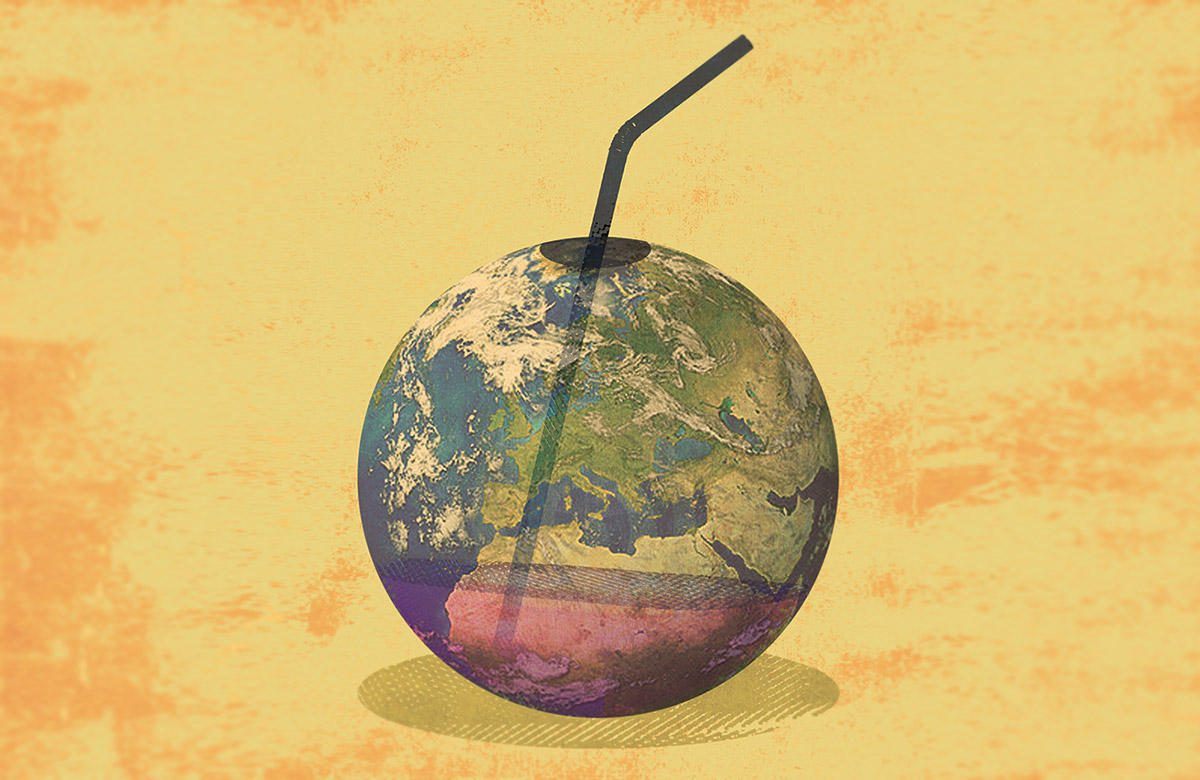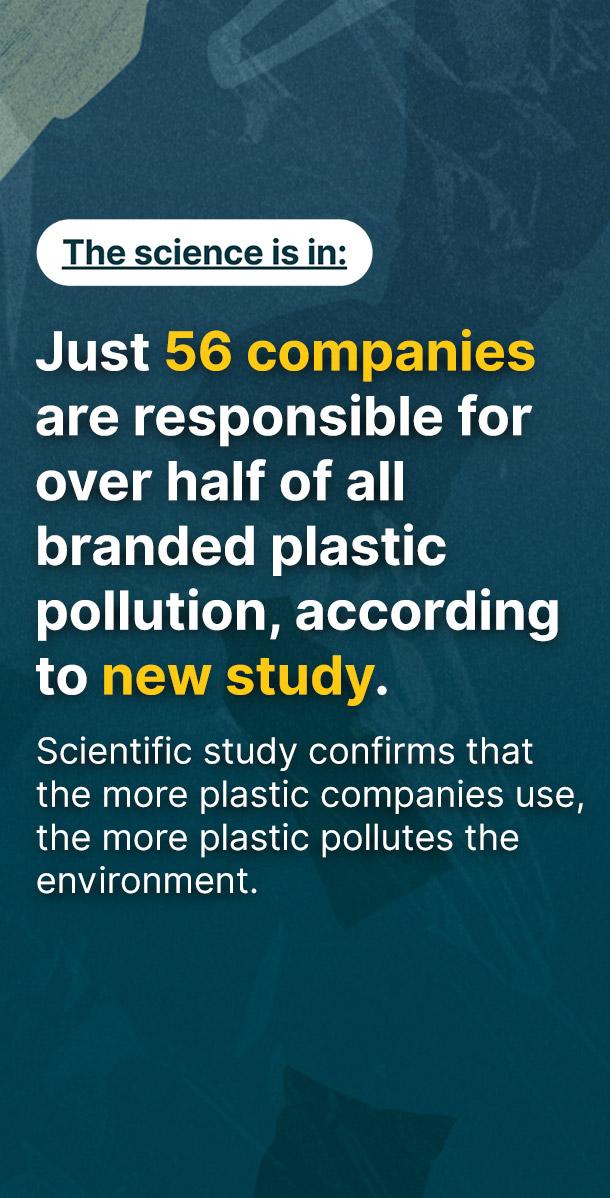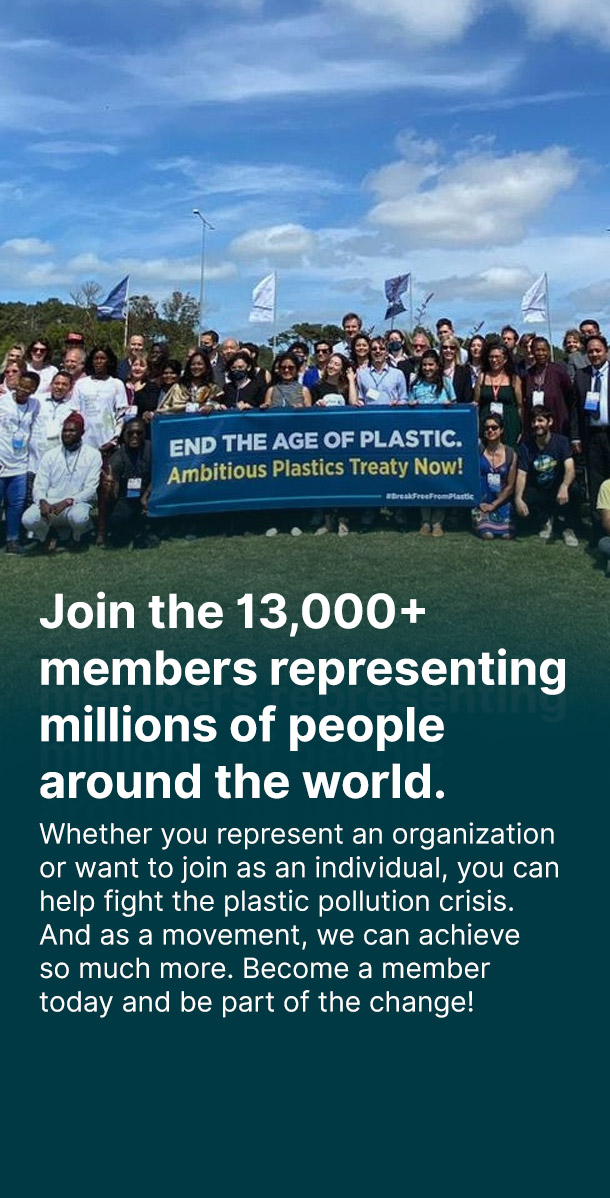This interview was originally published by the Green European Journal and can be found online in full here.
Green European Journal: As coordinator of the global Break Free From Plastic movement and the Rethink Plastic Alliance, can you describe the global picture of the plastics problem today?
Delphine Lévi Alvarès: Over the past decades, plastics has become a worsening crisis. It is now the fastest growing pollutant and travels all over the world. Scientists have found plastic in the deepest oceans and on the most remote beaches, and even in the air we breathe and the water we drink. But that is just the visible part of plastic pollution. For decades, we have addressed plastic only as a marine litter problem, but really it’s all along the plastics value chain. Stopping plastic leaking into the environment, and into the ocean in particular, requires working upstream to reduce the production of plastics, the quantity of polymers on the market, and the chemicals added to plastic products.
Today, it is absolutely necessary to take this holistic approach. Plastic pollution starts at the extraction stage because about 99 per cent of plastic comes from fossil fuels, either oil or gas. It’s also about product design. Products must be designed to be long lasting, reusable, and toxic free for safe recycling. At the waste management stage, a lot of plastic products are not recyclable or not collected for recycling, which means that new plastic needs virgin material. And because recycling doesn’t capture the whole stream, plastic ends up in landfills where it eventually degrades and releases chemicals additives. Or it’s incinerated – which is effectively burning the fossil fuels it comes from – and releases pollutants and CO2 into the atmosphere.
So recycling is no silver bullet….
Plastic recycling can produce quite a lot of pollution, depending on how it is done. And in most cases, recycling is actually downcycling. It’s quite rare that we manage to recycle a product into the same kind of product. Usually plastics from packaging won’t be used again for packaging because in the recycling process they’re mixed with different kinds of plastics that may include chemical additives, and it’s too dangerous to have these end up in our food wrappers. Studies have found toxic chemicals, mainly flame retardants, in children’s toys made from plastics recovered from electronic devices.
All over the world the petrochemicals industry is investing hugely in producing new virgin plastic. We’re talking about an additional 100 million tonnes of plastic production per year. The 12 million tonnes that are leaking into the environment today are nothing compared to what’s coming up if we don’t take action at the production stage.
Are some countries ‘worse’ than others when it comes to plastic production and pollution?
We’ve been pointing fingers at Southeast Asia for quite some time now, saying that they’re the biggest polluters. As a global movement, Break Free From Plastic knows that the story is actually quite different around the world. Packaging in Southeast Asia is unlike what we see in Europe, mostly coming in a small, multilayered, non-recyclable format. There are a lot of plastic sachets, wraps, bags, and straws. Producers are selling a Western lifestyle but adjusting it to the resources of people there and making it harmful for them directly. Europe has made quite some progress on product design for some specific products because we have extended producer responsibility schemes that require companies to take responsibility for the social and environmental impact of the products they sell. However, these companies tend to follow double standards and act less responsibly in other continents, selling the same products there but in non-recyclable packaging and not contributing to the cost of waste collection and treatment.
These countries struggle to finance any kind of system that would help prevent leakage into rivers and the ocean. However, even in places where a lot of plastic goes into the oceans, a lot of solutions are possible and already taking off. In Asia there are zero-waste cities, places so clean that you could eat off the floor, just a few miles away from some of the giant dumps leaking into the ocean that are often shown on TV.
In recent years, the EU has been exporting half of its collected and sorted plastics, of which 85 per cent was shipped to China. Is China’s ban on imports of certain types of plastic waste at the start of 2018 an opportunity for Europe’s recycling industry?
Yes, definitely. If it’s cheaper to send waste to China or to an Asian or African country to be processed, waste management companies in Europe will send it there. If this is not possible, European recyclers will use the infrastructure that we have. Nevertheless, we will have to increase the recycling capacities in some countries and start recycling more items and plastics to prevent them from being incinerated.
In Asia there are zero-waste cities, places so clean that you could eat off the floor, just a few miles away from giant dumps leaking into the ocean
A lot of what Europe is sending to China is low-value, single-use plastics, mainly packaging. This is a moment to push for product redesign, rather than trying to find a plant in Europe that would be happy to recycle low-value plastics.
Would a concerted effort from the EU and China be enough to lead us to a ‘post-plastic’ world, or do we need to work more closely with other nations, in particular those with poor waste management systems? How important is EU leadership on plastics at the global level?
Even if the Chinese ban has been a wake-up call for some countries, particularly in the EU, it’s not a step forward for the global plastic pollution issue per se. China is doing this to protect and improve the quality of their own environment, but if plastic keeps being produced, used, and thrown away at this rate, it’s just going to end up somewhere else. Waste is now ending up in countries with even less capacity to handle it properly, so it might leak into the environment and harm the people handling it even more than before. Whole containers of plastic waste are bought by brokers and then split among different, often small family businesses, and handled in conditions that cannot be controlled. That’s where a lot of leakage happens.
But let’s be clear, a lot of plastic that is leaking into the environment in Asia actually comes from the US and from Europe. And when it’s not our waste directly, it’s often a product from our Western designers. The role of the EU is not only to make sure that producers act responsibly in Europe, but also to ensure that they are not applying double standards at the global level. If producers are taking responsibility in Europe by contributing to a system that will improve the design of products and cover part of the cost for collection, recycling, and treatment of waste, there is no reason not to do so other continents. It’s a global system with a global market for waste, product, and materials, so the answer has to be coordinated and the EU must take responsibility for the effects of its own companies and waste in other regions by supporting this process financially.
On May 28, the European Commission presented its proposal for a new directive on single-use plastics, which includes an outright ban on several throwaway plastic products. What’s your take on the Commission’s proposal?
This is definitely a leap forward in tackling plastic pollution, and a sign that the Commission has woken up. We handed over a petition in September 2017 with more than 700 000 signatures asking the Commission to think big, act big, deliver big. It’s a very positive sign that they are finally taking action on the top 10 items identified as the most problematic by scientific monitoring of marine litter. There is a big chance for this legislation to be implemented with a satisfactory level of ambition, and that this is going to have an important impact on the main sources of marine macro-pollution.
That being said, it’s a first step on some specific plastic items, while further items exist that are problematic and should be phased out. Besides, this proposal doesn’t address the chemicals issue. If we want to build the recycled material market, we need to clean the loop as early as possible in the value chain. We also don’t want to see single-use plastics being substituted by single-use products made from other materials that can contain the same chemicals, or worse.
Is it likely that the proposal will get the approval of Member States and the European Parliament?
We’ve seen quite a positive response from the media and from governments all over Europe after the directive’s publication. It was discussed extensively with governments before, and the plastics strategy was a first step in making plastics an EU issue and in building buy-in among Member States. That said, the situation is different across the EU. Some countries already had some of these regulations in place or planned and waste management is carried out differently from country to country. It’s likely that the debate will be passionate, but it’s still too soon to tell.
If we want to build the recycled material market, we need to clean the loop as early as possible in the value chain.
Even if we knew the positions of Member States at this stage, these could well evolve thanks to campaigning, awareness raising, and citizen mobilisation at the national level. Today we are witnessing a lot of people, such as in the slow food or zero waste movements, that want to change their lifestyle and ask for clean and safe products. What’s missing is the systematic availability of the offers or infrastructure to make sustainable alternatives available and cheap. This is where policies can help.
While it may be encouraging to have both the Commission’s strategy and directive, the lobby of the plastics industry is extremely big and influential. PlasticsEurope alone, one of the biggest lobbying groups in Brussels, declared its annual budget in 2016 as over 1.5 million euros. How great is the threat that industry lobbies and Member States will water down proposed action on plastics?
There has already been a lot of lobbying around the plastics strategy, and now industry lobbies are gearing up. They have been hiring quite some people in the last few months. Some companies that are members of PlasticsEurope or Recyclers, for example, are playing a double role by funding cleanups and so on — to clean up their public image as well! You see PlasticsEurope everywhere, but there is also a lot of lobbying that you don’t see. The chemicals industry is quite active but they are usually not that visible in the discussions. But ultimately it’s the same lobbies. The fossil fuels lobby, the chemicals lobby, and the plastics lobby – they are different people but they have the same interest because the companies are integrated to some extent. Plastic producers are often branches of chemicals companies, for example. It’s highly interconnected.
There are big lobbies here, but it’s really a matter of quality of the arguments rather than size. They might have a lot of money for studies, but in the end a lot of the life-cycle analysis that they use is very questionable, and even with our small budget we’ve managed to counter them to some extent. For example, one of their main arguments regarding the plastic strategy was that packaging is essential to fight food waste – but this is really not the case. In April, we published a study on plastic packaging and food waste debunking some of the myths spread by the plastics industry.
What hopes does the Rethink Plastic Alliance have for the near future, and what can NGOs and citizens do now to ensure continued progress on combating the plastic crisis beyond the directive?
We will keep working with the Parliament and the Council on the newly tabled single-use plastic legislation and other political or technical processes where plastic is addressed. Even if the focus right now is on single-use plastics, other issues, like the one of chemicals in plastics, are critical to tackle plastic pollution and build a circular economy. It’s also important to prepare for the next mandate to make sure the plastic issue isn’t dropped. There is now legislation on single-use plastics – just a first step and certainly not the last – so mobilisation at the national level involving policy-makers, citizens, and businesses is key to ensure that better options are available to people and that alternative business models are developed and implemented.
There are big lobbies here, but it’s really a matter of quality of the arguments rather than size.
These are things that we’re already doing, but it’s about intensifying them and building visibility so that national decision-makers who are playing a role in the debate at the EU level will have it in mind and go in the right direction. As it’s a global issue as well as an EU policy issue, we will keep using the network and the movement to show EU institutions that people outside Europe are watching and have high expectations.
To contribute to meeting the aims of the Commission’s plastic strategy, the 2021-2027 EU budget proposes to introduce a plastic-based EU tax in which Member States would pay 0.80 euro into the EU budget for every kilo of plastic packaging waste not recycled. Do NGOs support that proposal, and is it likely to get the Council’s support?
We do not support this measure, as it does not create any incentive to reduce plastic production or consumption. Moreover, it’s going to be once again the Member States, the taxpayers, who are made to pay, instead of the companies responsible for products not being recyclable. Member States haven’t been given the chance to implement existing measures on waste collection and recycling before this tax has been suggested, and even those that were going to meet the waste directive’s targets are going to be taxed anyway.
If we really want to have an impact on plastic pollution, we have to move away from end-of-life economic incentives and tackle the existing obstacles to a circular economy for plastics, such as the low price of crude oil that encourages companies to use virgin plastic. Europe is now producing plastics from fracked hydrocarbons imported from the US, so another option could be to tax hydrocarbons. It’s really at a very early stage in the production chain that we have to intervene to have an impact downstream.
Bioplastics have been presented by some as a cleaner and more sustainable alternative to fossil fuel-based plastics. What is the NGO take on bioplastics?
Firstly, it’s important to distinguish between bio-based and biodegradable plastics. Bio-based tells you about where they came from – the feedstock – while biodegradable is a property of the plastic. It’s also important to recognise that bio-based plastics, at least at this stage, almost always contain some fossil fuel-based plastic. Most of the bio-based feedstock that enters the market today still comes from food crops such as corn, sugarcane and beetroot, replacing the food crops cultivated for the local people’s needs. Bio-based feedstock usually comes from very intensive agriculture involving GMOs and a lot of pesticides, and is imported from countries, like Argentina, where it has a big impact on the overall equilibrium of the ecosystem. Also, bioplastics are not necessarily clean – they can still contain the same additives and chemicals as in other kinds of plastics – so just switching to another feedstock is not a solution. The solution is really prevention at source.
Promoting biodegradable products sends the message to people that littering is OK because the waste is going to biodegrade.. And when it comes to waste management, biodegradable plastics can contaminate the recycling or the composting system. As they are not recyclable in the same way as normal packaging, putting them into a separate collection system will make the whole waste stream less dense, and potentially less viable and profitable.




